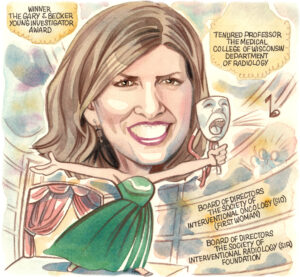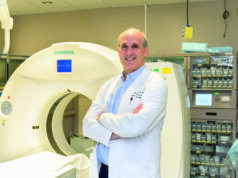
Sarah B White (Milwaukee, USA) dons many titles, namely she is a tenured professor of vascular and interventional radiology, a professor of surgery and surgical oncology, as well as associate dean at the Medical College of Wisconsin (MCW). Among her designations, White has been recognised as a ‘triple threat’, excelling as a researcher, clinician and professor, breaching brand new territory, not only for women in the field of interventional radiology (IR), but for all, taking on previously unexplored topics. Through research, White’s focus has been interventional oncology (IO), specifically developing new drug platforms and delivery methods to overcome treatment resistance, and to better understand the role of the tumour microenvironment including hypoxia. Here, White speaks to Interventional News about her love for IR and how she built her career in the field.
What attracted you to a career in medicine, and what made you choose IR?
I was born at Oregon Health & Science University (OHSU) in Portland, USA, when Charles Dotter was walking the halls. I am convinced that when I was born, Dotter sprinkled fairy dust on my mother and that’s what drove my ever-present and undying loyalty and devotion to IR. In reality, we had a close family friend, Robert Seigel, who practiced neurointerventional radiology (NIR). I remember being at his house playing with his kids when he came home from work. He told me about a tough case he had, where he performed the balloon procedure on a sick woman. It was at that moment, that I knew there was no other career for me. All these years later, Bob actually called me to refer a patient, who flew across the country to seek care with me here at MCW.
Who have been your mentors throughout your career?
I have had the absolute privilege of having truly amazing mentors throughout my career. After graduating from college with a degree in German, I was lucky enough to attend a post baccalaureate programme and the University of Pennsylvania (PENN) where I completed my prerequisites for medical school. During this time, despite having virtually no experience in research, Frank Lee hired me after I responded to an ad in the newspaper. He was a new principal investigator and needed lab staff. Only two short years later, we published, with me as first author, a truly novel finding in science. Hypoxia-inducible factor 1 (HIF)-1 was modified by a proline hydroxylation. I went off to medical school and had the good fortune of working with Brad Wood, who saw the fire in my belly. He has written letters of recommendation for me for residency, FSIR, and all my promotions. His charisma and undying love of IR was contagious.
During residency, I had the privilege of working with a phenomenal team and was mentored by Rich Schlansky-Goldberg, Scott Trerotola, Bill Stavaropolous, Max Itkin, Jeff Solomon and Aalpen Patel. This team of amazing mentors challenged me every day and made sure that I would be not only a good interventional radiologist, but a good partner, teacher and researcher. I am still in touch with each and every one from PENN IR and continue to learn from them. I do not include Michael Soulen in the list with the other PENN faculty, because Michael has been more than a mentor. He has been a mentor, a coach, a sponsor, and now, a true friend. His frank feedback and ongoing expectation of excellence helped me grow and led me into a career that I truly love. His best advice was that if you have the fire in your belly, you will be successful.
Now, I have the good fortune or working alongside a brilliant group of interventional radiologists that continue to mentor me today. Bill Rilling stood beside and mentored me as I fumbled through cases early in my career and has helped guide me though all of my leadership roles. Bill has an unending cadre of wisdom. I was on call and called him for advice and he said: “You know what to do, go get ‘em tiger”. Robert A Hieb has been my biggest cheerleader and always answers my calls at 2am when I’m stuck doing a challenging vascular case. Parag Patel has been a quiet voice in the background keeping me sane and helping me through the challenges of academic medicine. Sean Tutton taught me how to have a voice among the many loud voices in academic medicine. Eric Hohenwalter has been the voice of reason and clarity and always showed me kindness and compassion.
Nationally, I have had the good fortune of having a tremendous network of mentors including Alda Tam, Nishita Kothary, Reed Omary, Andrew Larsen, Matt Callstrom to name a few.
Could you describe a case that has been the most memorable thus far?
I have had innumerable memorable cases throughout my career. I will however relay a story of one of the kindest patients I had the honour of treating. She initially presented to me for consideration for a transjugular intrahepatic portosystemic shunt (TIPS), because she had refractory ascites. I reviewed the imaging which revealed that she had a recurrence of her pancreatic cancer, which she believed to be in remission. She walked in thinking that we were having a conversation of fluid management and walked out with the devastating news that her cancer was back. I had never met this patient before that visit and had no relationship with her. I however delicately and carefully explained the situation to her. We ended up agreeing to placing a Denver shunt to manage the ascites. A week later, while doing the procedure, she kept telling me that I was doing a good job. It turned out that she was a seamstress and was making her daughter’s wedding dress for a wedding that was just a few short months away.
She re-presented a week before the wedding and I was called by the intensive care unit (ICU) as she had been admitted with septic shock, and the ICU team were advising that the patient and her family transition to a hospice. She and her family however were unwilling to make any decisions without first talking to me. I immediately went up to the ICU. They believed that the source of her infection was the Denver shunt, and because her daughter’s wedding was just a week away, I convinced the ICU team to aggressively treat her, as we just needed to get to the wedding. I went bedside and removed the shunt, again, all the while her cheering me on and repeatedly telling me what a good job I was doing. The procedure was successful, and she was discharged with enough time to finish the wedding dress and attend the wedding, although in a wheelchair.
After the festivities, she went home to find a kitten eagerly awaiting her, something she had always wanted. She died a few days later, surrounded by family and while petting her kitten. Though we can’t always cure patients, we can advocate for them to achieve their goals, and help them die peacefully and with grace. This dear patient also showed me that complications don’t define you, but how you handle them does.
 You were the first in the USA to be accepted and graduate from the direct pathway at the University of Pennsylvania Hospital. How did this come about and what was your experience?
You were the first in the USA to be accepted and graduate from the direct pathway at the University of Pennsylvania Hospital. How did this come about and what was your experience?
As a medical student, I went to the Society of Interventional Radiology (SIR) conference. They held a medical student breakfast, which was attended by Al Nemcek and Bob White. There were eight medical students at the breakfast. Nemcek told me about this new training pathway that was going through the approval process and would not be ready for me. As soon as I heard about it, I went to the SIR website and emailed all of the programme directors at the schools listed as being part of the direct pathway. Michael Soulen, at the hospital of the University of Pennsylvania, was the only person to respond. He sent me some detailed information, but told me that he didn’t want to discuss anything further and to contact him “if” I got an interview at PENN.
Within minutes of being offered an interview a few years later, I contacted Michael again. Back then, all the interviewees came to PENN during the same weekend. At the dinner on Friday night, Michael found me, and I sat and had dinner with all of the PENN IR faculty. When it came time for the match, Michael called me and told me that I had been selected to join them as the first direct pathway resident in the country. The caveat was that the programme had not been officially approved yet. I jumped at the chance, matriculated that July and luckily, the programme was officially approved.
In 2024 you published a paper outlining why IR and diagnostic radiology (DR) should stay in alignment. If they were to be separated, how do you believe IR would be affected?
As the US healthcare system moves more towards a work relative value unit (wRVU)- based reimbursement structure, IR separating from DR will make us vulnerable by falling short of financial metrics. DR also has a larger footprint and therefore is more often invited to sit at the table with hospital executives and policymakers to pursue the ongoing needs of IR. Globally, IR sees patients have limited access to our specialty, and a break may further prevent access to care. Finally, the core of our specialty is our expertise in marrying imaging with procedures. If we lost the robust education we have in imaging, I believe our specialty would suffer greatly.
What have been some of the most important developments in IR and IO over the course of your career so far?
IR has undergone tremendous change during my career. We have moved from a subspecialty designation, to designation as a primary specialty. Medical students can now match directly into IR residency programmes. We have evolved in the research realm from being perceived as proceduralists, to being perceived as true scientists, by running such pivotal trials as ATTRACT, CTRACT, PE-TRACT and RETNET. We have secured a seat at the table in oncology care by being on the National Comprehensive Cancer Network (NCCN) panels and founding a society solely dedicated to oncology procedures, with the Society of Interventional Oncology (SIO).
What does your life outside of medicine look like?
I am the mother of three amazingly kind, respectful, empathetic and intelligent children. My mornings are filled with making lunches and walking the kids to school. Evenings are filled with lots of laughter, violin practice, homework and reading bedtime stories. My kids constantly remind me to not sweat the small stuff and that joy and fun can be found everywhere. I love the outdoors, hiking, travelling and cooking.










